|
|
|---|
Wednesday, October 27, 2010
Antonov An-225 One Of Largest Plane In The World-
2 Apr 2009 ... The Antonov 225 is, hands down, the largest plane in the world. So why would a plane this size need to fly the skies
When the Wright brothers flew their first plane they were elated. They had accomplished a feat no man had ever dreamed possible. Today we have planes of varying shapes and sizes, carrying individuals, small groups of passengers, cargo and packages, or hundreds of people at a time.Despite the advances in technology over the years, it’s still difficult to comprehend something as monstrous as the Antonov 225 staying afloat in the skies. Contrary to popular belief, an aircraft of this size does not have a very recent design history. As a matter of fact, the Antonov 225 has been trailing the skies since the late 1980’s.

An-225 Mriya | |||
|---|---|---|---|
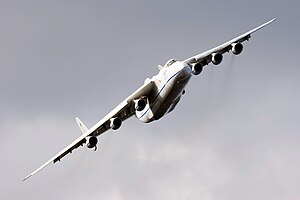 | |||
| The Antonov-225 at Hostomel Airport (Antonov airport), Ukraine | |||
| Role | Strategic airlifter | ||
| National origin | Soviet Union / Ukraine | ||
| Manufacturer | Antonov | ||
| First flight | 21 December 1988 | ||
| Status | Operational | ||
| Primary user | Antonov Airlines | ||
| Produced | 1988 | ||
| Number built | 1 | ||
| Developed from | Antonov An-124 | ||
The Antonov An-225 Mriya (Ukrainian: Антонов Ан-225 Мрія, NATO reporting name: 'Cossack') is a strategic airlift cargo aircraft, designed by the Soviet Antonov Design Bureau. It is the world's heaviest fixed-wing aircraft. The design, built to transport the Buran orbiter, was an enlargement of the successful An-124 Ruslan. The An-225's name, Mriya (Мрiя) means "Dream" (Inspiration) in Ukrainian.
The An-225 is commercially available for flying over-sized payloads due to the unique size of its cargo deck. Currently there is only one aircraft in operation.
Development-

Space shuttle Buran being carried by the An-225
The Antonov An-225 was designed for the Soviet space program as a replacement for the Myasishchev VM-T. Able to airlift the Energia rocket's boosters and the Buran space shuttle, its mission and objectives are almost identical to that of the United States' Shuttle Carrier Aircraft.
The An-225 first flew on 21 December 1988. The aircraft was on static display at the Paris Air Show in 1989 and it flew during the public days at the Farnborough air show in 1990. Two aircraft were ordered, but only one An-225 (tail number UR-82060) was finished. It can carry ultra-heavy and oversize freight, up to 250,000 kg (550,000 lb) internally, or 200,000 kg (440,000 lb) on the upper fuselage. Cargo on the upper fuselage can be 70 metres (230 ft) long.
A second An-225 was partially built during the late 1980s for the Soviet space program. The second An-225 included a rear cargo door and a redesigned tail with a single vertical stabilizer. It was planned to be more effective for cargo transportation. Following the collapse of the Soviet Union in 1991 and the cancellation of the Buran space program, the lone operational An-225 was placed in storage in 1994. The six Ivchenko Progress engines were removed for use on An-124s, and the second uncompleted An-225 airframe was also stored. The first An-225 was later re-engined and put into service.
By 2000, the need for additional An-225 capacity had become apparent, so the decision was made in September 2006 to complete the second An-225. The second airframe was scheduled for completion around 2008, then delayed. By August 2009, the aircraft had not been completed and work had been abandoned.
Design-
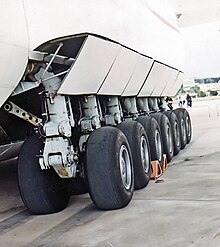
An-225 main landing gear
Based on Antonov's earlier An-124, the An-225 has fuselage barrel extensions added fore and aft of the wings, which received root extensions to increase span. Two more Ivchenko Progress D-18T turbofan engines were added to the new wing roots, bringing the total to six, and an increased-capacity landing gear system with 32 wheels was designed. The An-124’s rear cargo door and ramp were removed to save weight, and the empennage was changed from a single vertical stabilizer to a twin tail with an oversized horizontal stabilizer. The twin tail was essential to enable the plane to carry large, heavy external loads that would disturb the aerodynamics of a conventional tail. Unlike the An-124, the An-225 was not intended for tactical airlifting and is not designed for short-field operation.

An-225 Ivchenko Progress D-18T turbofan engines
Initially the 225 had a maximum gross weight of 600 tonnes (1,320,000 lb) but the aircraft was modified in 2000-01, at a cost of US$20M, with a reinforced floor that increased the maximum gross weight to 640 tonnes (1,410,000 lb),
Both the earlier and later takeoff weights establish the An-225 as the world's heaviest aircraft, being heavier than the double-decker Airbus A380 even though Airbus plans to pass the An-225's maximum landing weight with 591.7 tonnes (1,304,000 lb) for the A380. The Hughes H-4 Hercules, known as the "Spruce Goose", had a greater wingspan and a greater overall height, but was 20% shorter, and due to the materials used in its construction, also lighter. In addition, the Hercules only flew once and never climbed above 21.3 m (70 ft), making the An-225 the largest aircraft in the world to take off multiple times. The An-225 is not only larger than the Airbus A380 airliner, it is also considerably bigger than the Antonov An-124, Boeing 747 Large Cargo Freighter, and Lockheed C-5 Galaxy, the nearest equivalent heavy cargo aircraft.
Operational history-
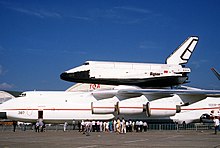
The An-225 at the 38th Paris International Air and Space Show in 1989
In the late 1980s, efforts were begun by the Soviet government to generate revenue from its military assets. In 1989, a holding company was set up by the Antonov Design Bureau as a heavy airlift shipping corporation under the name "Antonov Airlines", based in Kiev, Ukraine and operating from London Luton Airport in partnership with Air Foyle HeavyLift.
As the Soviet space program was in its last years, the An-225 was considered and accepted to be the prime way to transport the Buran Shuttle.
The company initiated operations with a fleet of four An-124-100s and three Antonov An-12s, but by the late 1990s a need for aircraft larger than the An-124 became apparent. In response, the original An-225 was re-engined, modified for heavy cargo transport, and placed back in service under the management of Antonov Airlines.

Antonov An-225 at Manchester Airport in 2006
On 23 May 2001, the An-225 received its type certificate from the Interstate Aviation Committee Aviation Register (IAC AR). In September 2001, carrying a record load of 253.82 tonnes (279.79 short tons) of cargo, the An-225 flew at an altitude of 2 km (6,600 ft) over a closed circuit of 1,000 km (620 mi) at a speed of 763.2 km/h (474.2 mph).
The type's first flight in commercial service departed from Stuttgart, Germany on 3 January 2002, and flew to Thumrait, Oman with 216,000 prepared meals for American military personnel based in the region. This vast number of ready meals was transported on some 375 pallets and weighed 187.5 tons.
Since then, the An-225 has become the major workhorse of the Antonov Airlines fleet, transporting objects once thought impossible to move by air, such as locomotives and 150-ton generators, and has become a valuable asset to international relief organizations for its ability to quickly transport huge quantities of emergency supplies during disaster relief operations.

An-225 doing a fly-by.
Beginning in June 2003, the An-225, along with An-124s, delivered over 800 tons of equipment to aid humanitarian efforts in Iraq.
The An-225 has also been contracted by the Canadian and U.S. governments to transport military supplies to the Middle East in support of Coalition forces. In November 2004, FAI placed the An-225 in the Guinness Book of Records for its 240 records.
On 11 August 2009, the heaviest single cargo item ever sent via air freight was loaded onto an Antonov 225. At 16.23 metres (53.2 ft) long and 4.27 metres (14.0 ft) wide, the consignment–a generator for a gas power plant in Armenia and its loading frame–weighed in at a record 189.09 tonnes (416,900 lb). Also during 2009, the An-225 was painted in a new blue and yellow paint scheme, after Antonov ceased cooperation with AirFoyle and partnered with Volga-Dnepr in 2006.

Antonov An-225 in 2010
In February 2010, the An-225 transported 108 tonnes of construction machinery from Japan to Santo Domingo, Dominican Republic for quake-stricken Haiti.
On 11 June 2010, the An-225 carried the world's longest piece of air cargo, when it flew two new 42-meter wind turbine blades (test subjects) from Tianjin, China to Denmark.
An example of the cost of shipping cargo by An-225 was 266,000 Euro for flying a chimney duct from Denmark to Kazakhstan in 2008.
Images for largest airplane in the world-
Thank you for the feedback. Report another imagePlease report the offensive image. CancelDone
- I'm confused by the way the record for largest plane is determined. I read that the largest airliner in the world is the 747-400, and then I read it is the An-225. Similarly, I read that the plane with the largest wingspan is the Spruce Goose, and then I read about an airliner called the Bristol Brabazon with a wingspan larger than the 747! Could you please define the records, if any, that these aircraft hold with EXACT wording to the particular record? - question from Jack
Aircraft records can indeed be confusing. If you need any reminder of that observation, try looking through the records on the FAI website. FAI, short for Fédération Aéronautique Internationale, is the international body that officially recognizes aviation and space records. However, most of the information on that site concerns aircraft performance, such as speed and altitude, rather than size.
Your question really comes down to how you decide to compare one plane to another. One of the measurements you mention is wingspan. While this dimension is often used to compare overall size, it is generally not the most accepted measure. Aircraft are usually ranked by weight, the maximum takeoff weight in particular. By this measure, the world's largest plane is the Antonov An-225 built in Ukraine when it was part of the Soviet Union.
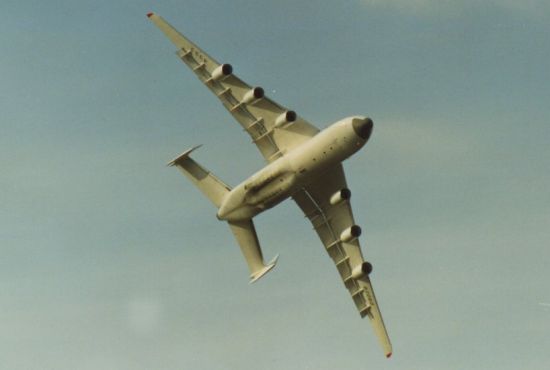
An-225, largest plane in the world
If we continue to measure by maximum takeoff weight, the next largest plane in the world would be either the related An-124 transport or the Boeing 747 airliner. Both aircraft are quoted with a maximum weight around 900,000 lb (405,000 kg). The An-124 was also built by the Soviet Union as a large cargo plane for both military and civil use. The basic design was later enlarged and adapted to produce the An-225.

An-124
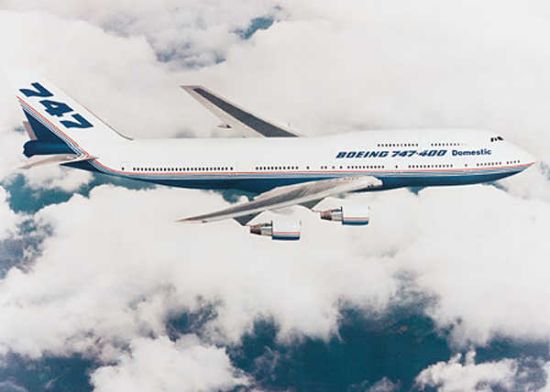
Boeing 747
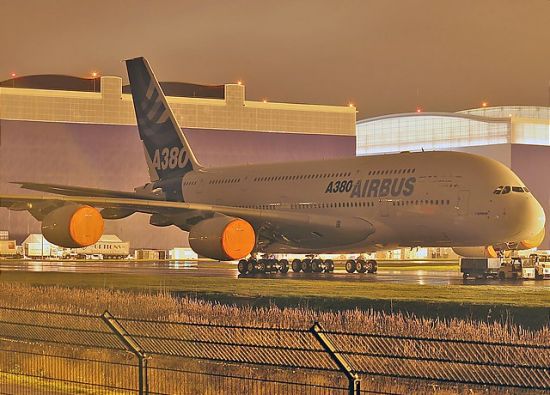
Airbus A380
Your question also mentions two other classic aircraft that were certainly enormous by any measure. Unfortunately, both proved to be disastrous follies that were great embarrassments to their proponents. The Spruce Goose, officially known as the Hughes H-4 Hercules, was the brainchild of flamboyant billionaire Howard Hughes. The aircraft had originally been ordered by the US government during World War II as a giant cargo plane ferrying up to 750 armed troops or two 30-ton tanks. As the war concluded, Hughes believed he could adapt the massive plane to revolutionize long-distance transportation in the fledgling airline and air cargo industires. His creation was the world's largest plane at the time and is still the largest flying boat ever built with a maximum takeoff weight of 400,000 lb (180,000 kg). The enormous craft also holds records for the largest wingspan at 319 ft 11 in (97.5 m), tallest airplane at 79 ft 3 3/8 in (24.2 m), and the largest aircraft ever made from wood.
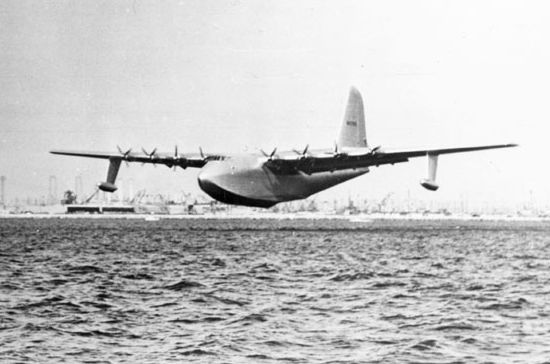
Spruce Goose during its only flight
Like the Spruce Goose, the Bristol Brabazon was another a government-sponsored effort intended to advance the state of the art in long-distance travel. The Brabazon was funded by the UK during the 1940s to develop a large airliner capable of non-stop flights between London and New York. Though smaller than the Spruce Goose, the Brabazon would have easily been the largest airliner of the day with a takeoff weight of 250,000 lb (115,000 kg) and a wingspan of 230 ft (70 m).
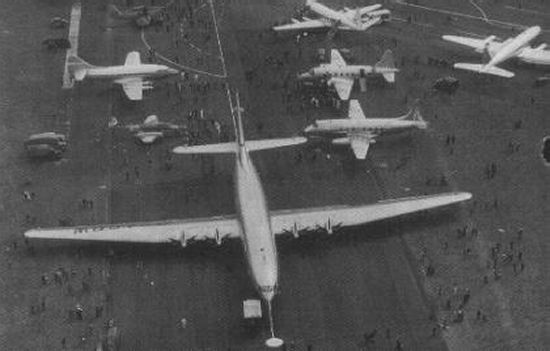
Bristol Brabazon compared to other planes of the day
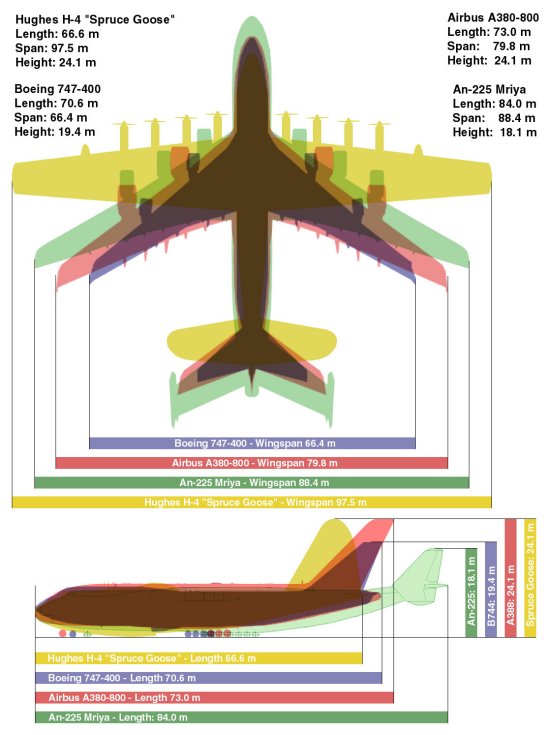
Relative size comparison of the Spruce Goose, An-225, A380, and 747
- answer by Molly Swanson, 8 August 2004
Additional Rankings:
Since this article was posted, we have received several messages from readers who believe the C-5 Galaxy transport operated by the US Air Force ranks second or third place and should be included. The C-5 was the world's largest plane when it was introduced in the late 1960s, but it has since been overtaken by the jet-powered aircraft discussed above.
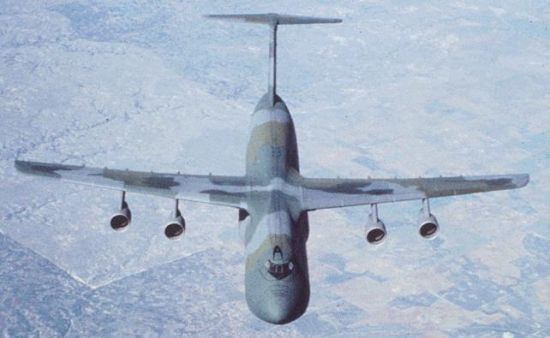
The world's largest airplane the Airbus A380. There were a lot of orders for this French airplane at the Annual Paris Airshow. 7 May 2007 ... Top 50 Largest aircraft in the world -- GlobalAircraft.org. ... The An-225 Cossack is the largest airplane in the world.
Airbus A380. The World's Largest Airplanes ... The world's biggest airplane is the Antonov An-225 cargo plane, however only one An-225 is in operation. .
Labels: airplane news, history and vedio clip also., picture
0 Comments:
Subscribe to:
Post Comments (Atom)















